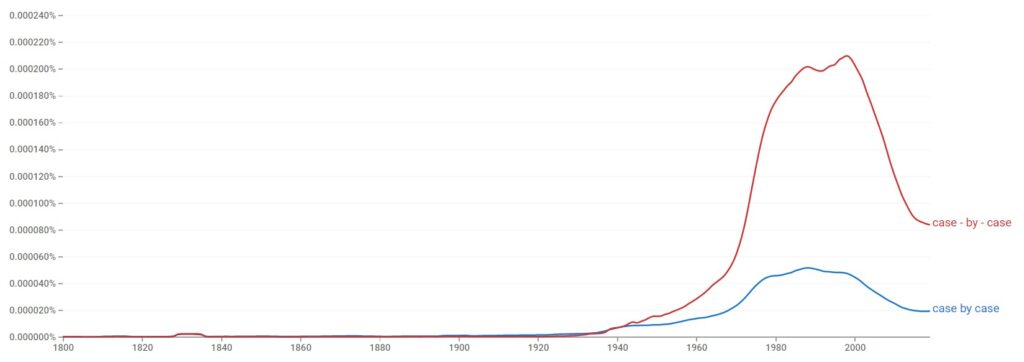When you want to use “case by case” in your writing, it will help to know whether it’s hyphenated or not. Some people write it as more than one or two words, so this article will help to clear up any confusion you might have surrounding it.
Case by case vs. Case-by-case
“Case by case” does not need to be hyphenated when it is used as a noun phrase. We use it in this form when no other nouns are present to modify. “Case-by-case” should be hyphenated whenever a noun is present, and a modification is required.

According to Google Ngram Viewer, “case-by-case” is more popular as a hyphenated variation. However, it’s also clear that “case by case” is still a suitable option. It depends entirely on what you are writing about and whether another noun is present.

The Oxford Dictionary defines “case by case” without any hyphens present, while The Cambridge Dictionary defines “case-by-case” with the hyphens. Oxford states the unhyphenated form is a “phrase,” while Cambridge states the hyphenated form is an “adjective.”
However, The Oxford Dictionary also provides examples showing how the hyphenated form works as an adjective. When a noun comes directly after the words, we can see that we must group them up with hyphens to change the meaning.
If you’re struggling to understand the main differences between the noun and adjective form, you can refer to the following:
- Adjective: We can get this all sorted out on a case-by-case basis if you think that’s better.
- Noun: We will take it case by case. Only then will we understand more about what’s happening around us.
Case by case
“Case by case” is correct when it is a noun phrase. We do not use it to modify any other part of the sentence, and it shows that something will be tackled systematically or with a “case by case” approach. Any hyphenation in this form would be unnecessary.
The idea of using it without hyphens is to show that “case” and “case” are affected by the preposition “by.” This shows that each “case” will be looked at independently until an answer is worked out.
You might benefit from a couple of these examples:
- I would like to revisit this case by case. Then I think I’ll be able to get a brighter picture.
- You should have worked it out case by case. Instead, you rushed it, and now we’re paying the price for your mistakes.
- I like working slowly. Case by case is the only way I’m happy to move!
- We shouldn’t have done this case by case. It’s led to a lot of issues on the production line!
Case-by-case
“Case-by-case” should be hyphenated when it’s used as an adjective. In this form, it’s common for a noun to come directly after it. The hyphens work as connectors to show that the three words all group up to change the meaning of the noun.
According to the AP Stylebook, we must hyphenate more than one word when they are used to modify the same noun. We can figure out whether this is required based on the position of the noun in a sentence.
For example, if a noun like “basis” is written after “case by case,” then AP Style teaches us to hyphen “case-by-case” to show that all three words modify “basis.”
Here are a few examples to help you with it:
- I’m going to take a look through these with a case-by-case approach, and that’s as fast as I’m willing to go.
- My case-by-case information isn’t fast enough to generate any new leads.
- I will look into your work on a case-by-case basis while filing this report.
- Can we get a case-by-case evaluation next time? I think that’ll give us fairer results.
Is “By-Case” Capitalized In The Word “Case-By-Case”?
You typically do not need to capitalize any part of “case-by-case.” You would only capitalize it if it’s a proper noun, but we use the hyphenated form as an adjective with no proper nouns inside it.
However, when writing it as part of a title, you might choose to capitalize every part of the word. This only works if you like to capitalize every other word that’s written in your title.
